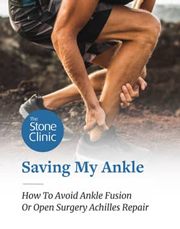Patient Avoids Ankle Fusion with BioAnkle Cartilage Repair Surgery
I broke both my tibia and my fibula and completely in half. So I completely dislocated my foot from my leg and they gave me 13 screws and about a five or a six-inch plate to put my bones back together. I went through all the therapy and all the treatment for that. And then the ankle never quite felt exactly right. But it started swelling and having a lot of pain. I ended up having a surgery where they removed all of the hardware from my right ankle. And even after that surgery though, after that healing time went by, it still wasn't really quite right. And I found that every single day, I kid you, not every step I thought about my ankle. And when you're, when that's all you're thinking about, you're not enjoying the moment. All you're thinking about is, well, is this the step that sets off a series of problems for me, you start thinking about the things you can't do, and now your life becomes about the things you can't do, as opposed to the things that you want to do.
You don't dream about doing things. We had the MRI, and of course, we found a very large area of dead bone, and we found this damage to my cartilage surface. I'm an attorney. And the type of work I do is, is personal injury and workers' compensation. So I see a lot of injuries and I also see a lot of fixes and I come across Dr. Kevin Stone and I'm reading his stuff and I'm thinking, well, this is crazy. This guy's done this 20 years ago because he has long-term studies. And he's talking about cartilage grafts and the different things that he was able to do, and the different, really good outcomes that he had. And I talked to three really good surgeons in Nebraska. I talked to this surgeon here, I look at the Mayo Clinic and I'm shocked that there aren't more doctors doing this, but in my discussions with him, my understanding was next procedure would end up being an ankle fusion.
I have seen people with ankle fusion. So I've seen what happens to their legs. And I, you see the atrophy that comes into play. I didn't want that for my life. I finally looked up Dr. Stone. I went through his process of getting a free consultation. And I thought, well, maybe he'll give me a sale. You know, you, you worry about people giving a sale sometimes like, Oh yes, this will be great, grand, and glorious. And he just very humbly said to me, David, I think we can save your ankle. And I knew, so I came to California to get my ankles fixed.
He had plates and screws placed by his orthopedic surgeon and unfortunately developed, what's called avascular necrosis or death of the bones around the ankle joint. He required extensive cartilage grafting, both from the knee and the hip to try to restore the dead bone around the ankle joint and to restore and try to regrow missing articular cartilage. He's still a work in progress since it's only been a period of months now since his ankle procedure, but he's been walking. He has improved motion, diminished pain, and is optimistic as we are for preserving his ankle for the future.
He's been coming in for two sessions every day, an hour and a half of table work and range of motion, manual therapy, and then going through another 45 minutes of a full-body workout. It's a lot of hard work. It takes a lot of discipline and him doing that so early on and being ready for that day two day three has just exponentially made his ability to recover mentally, physically, emotionally, that much better.
Don't get me wrong. I'm not an exercise person. I'm not a sportsperson. Like some of the people who come and get treatment here. Before I had my injury, I hated running. Now, honestly, I look forward to doing it even though I don't like the activity. When you finally get to the point of, "Hey, you can't do this." You suddenly want to do it. I just want to play soccer with my kids again. And that's one of those activities that I used to do before the injury I can't do now. But I will do it again someday. It was like a breath of fresh air because finally the opportunity to dream, again, to think about the things I want to do to think about the things that can be instead of can't.
David H. Profile
An ankle fusion procedure is still used to treat patients with end-stage arthritis where bone is painfully rubbing against bone. Our patient David was offered this course of treatment elsewhere, but, understandably, did not want to suffer the loss of mobility and limitations often associated with a procedure that would've fused the bones in his ankle joint together with screws, plates, and bone grafts.
Instead, David traveled to San Francisco where Dr. Stone repaired the dead bone and cartilage in David's ankle with a cartilage regeneration procedure that he personally developed: the articular cartilage paste graft. This minimally-invasive arthroscopic procedure stimulates regrowth of damaged articular cartilage surfaces, reforming durable cartilage tissue with long-term improvement in function and diminishment of pain. When applied to the ankle as part of a biologic reconstruction, we refer to this as a BioAnkle.
By partnering with The Stone Clinic team, David was able to avoid an ankle fusion and find the treatment solution that allowed him to "think about the things that can be."



